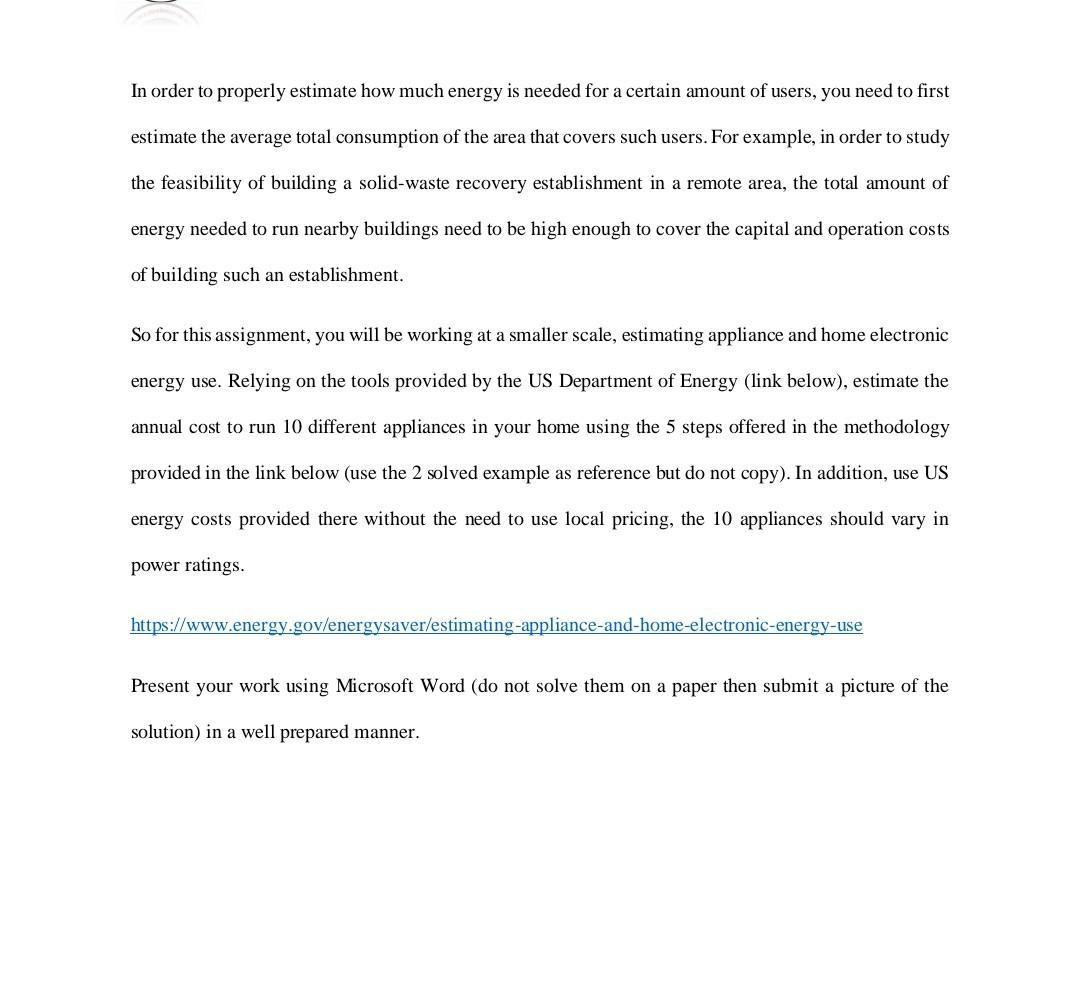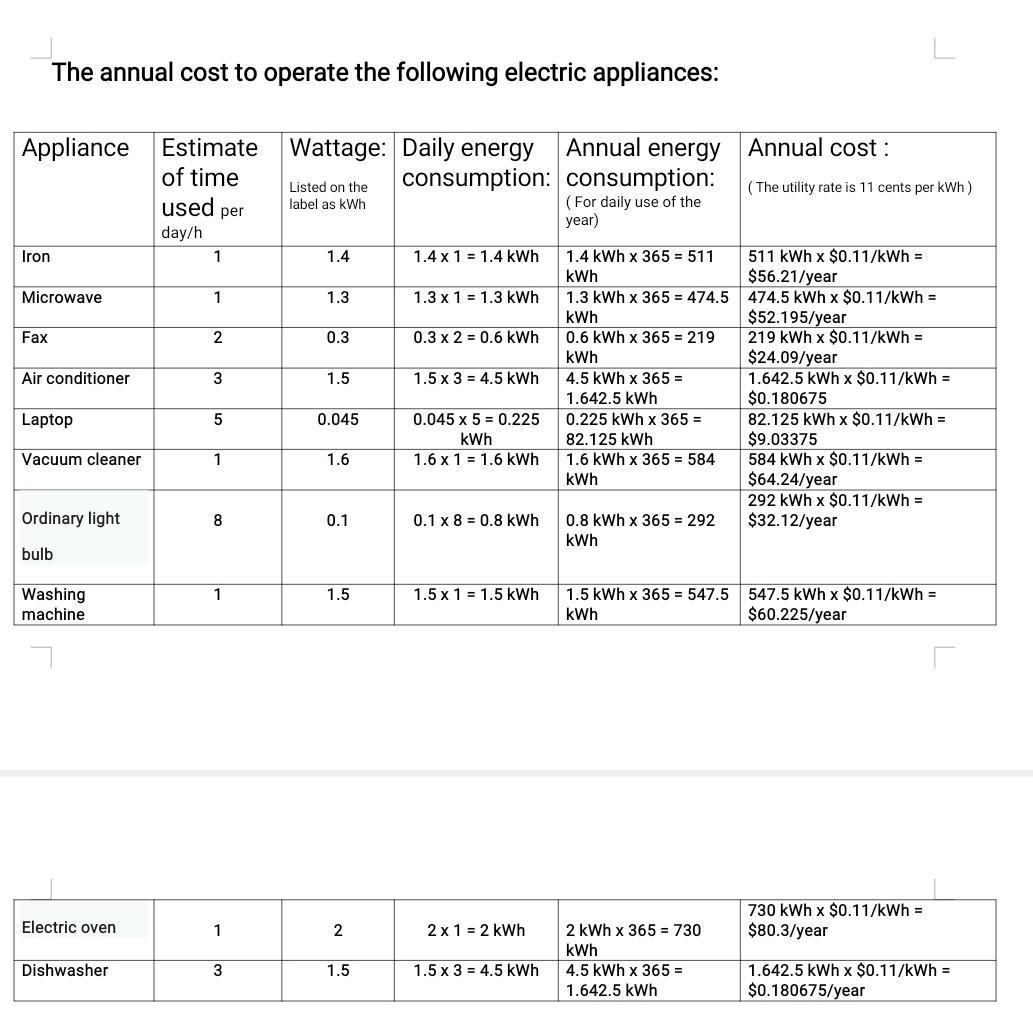In order to properly estimate how much energy is needed for a certain amount of users, you need to first estimate the average total


In order to properly estimate how much energy is needed for a certain amount of users, you need to first estimate the average total consumption of the area that covers such users. For example, in order to study the feasibility of building a solid-waste recovery establishment in a remote area, the total amount of energy needed to run nearby buildings need to be high enough to cover the capital and operation costs of building such an establishment. So for this assignment, you will be working at a smaller scale, estimating appliance and home electronic energy use. Relying on the tools provided by the US Department of Energy (link below), estimate the annual cost to run 10 different appliances in your home using the 5 steps offered in the methodology provided in the link below (use the 2 solved example as reference but do not copy). In addition, use US energy costs provided there without the need to use local pricing, the 10 appliances should vary in power ratings. https://www.energy.gov/energysaver/estimating-appliance-and-home-electronic-energy-use Present your work using Microsoft Word (do not solve them on a paper then submit a picture of the solution) in a well prepared manner. The annual cost to operate the following electric appliances: Appliance Iron Microwave Fax Air conditioner Laptop Vacuum cleaner Ordinary light bulb Washing machine Electric oven Dishwasher Estimate Wattage: Daily energy Annual energy Annual cost: of time used per day/h 1 1 2 3 5 1 8 1 1 3 Listed on the label as kWh 1.4 1.3 0.3 1.5 0.045 1.6 0.1 1.5 2 1.5 consumption: consumption: (For daily use of the year) 1.4 x 1 = 1.4 kWh 1.3 x 1 = 1.3 kWh 0.3 x 2 = 0.6 kWh 1.5 x 3 = 4.5 kWh 0.045 x 5 = 0.225 kWh 1.6 x 1 = 1.6 kWh 0.1 x 8 = 0.8 kWh 1.5 x 1 = 1.5 kWh 2 x 1 = 2 kWh 1.5 x 3 = 4.5 kWh 1.4 kWh x 365 = 511 kWh 1.3 kWh x 365 = 474.5 kWh 0.6 kWh x 365 = 219 kWh 4.5 kWh x 365 = 1.642.5 kWh 0.225 kWh x 365 = 82.125 kWh 1.6 kWh x 365 = 584 kWh 0.8 kWh x 365 = 292 kWh 1.5 kWh x 365 = 547.5 kWh 2 kWh x 365 = 730 kWh 4.5 kWh x 365 = 1.642.5 kWh (The utility rate is 11 cents per kWh ) 511 kWh x $0.11/kWh = $56.21/year 474.5 KWh x $0.11/kWh = $52.195/year 219 kWh x $0.11/kWh = $24.09/year 1.642.5 kWh x $0.11/kWh = $0.180675 82.125 kWh x $0.11/kWh = $9.03375 584 kWh x $0.11/kWh = $64.24/year 292 kWh x $0.11/kWh = $32.12/year 547.5 kWh x $0.11/kWh = $60.225/year 730 kWh x $0.11/kWh = $80.3/year 1.642.5 kWh x $0.11/kWh = $0.180675/year
Step by Step Solution
3.44 Rating (151 Votes )
There are 3 Steps involved in it
Step: 1
Introduction In this analysis we will estimate the annual cost of operating 10 different electric ap...
See step-by-step solutions with expert insights and AI powered tools for academic success
Step: 2

Step: 3

Ace Your Homework with AI
Get the answers you need in no time with our AI-driven, step-by-step assistance
Get Started


